On this page: |
Everywhere you turn today, it seems somebody is talking about cannabis.
Some of the information we hear about cannabis is conflicting, making it hard to understand the ways it may affect our children. Is it addictive? Does it cause psychosis? Is it really a medicine? What will happen if my child uses it? What should I tell—or not tell—my child about it?
As cannabis has now been legalized for adults in Canada, the Canadian Institute for Substance Use Research has revised and updated a previous resource developed in partnership with the F.O.R.C.E. Society for Kids' Mental Health and the Canadian Mental Health Association (BC Division). This new edition retains the aim of the earlier work.
Our goal is to offer you an honest and thoughtful discussion on cannabis so you can make better decisions about cannabis use—or non-use—in the context of your family.
Hemp. Cannabis. Marijuana. Hash.
Chances are you’ve heard these words before, though you many not know the difference between them. Are they the same or different? The answer is "both."
HEMP is a plant that, like other plants, has roots, a stalk, leaves, flowers and seeds. Hemp stalks are often used to make fibre-based items such as paper and fabric.
CANNABIS is the scientific name for the hemp plant. There are many different kinds of cannabis. The leaves and flowers of each kind produce varying mind-altering and medicinal effects when smoked or consumed. The most talked-about strains of the hemp plant are cannabis sativa and cannabis indica.
MARIJUANA is a Mexican slang word for cannabis leaves and flowers (aka buds).
HASH, short for hashish, is made of pressed resin from cannabis buds, and is therefore stronger in effect.
You may have heard...
You may have heard a variety of claims about cannabis in the media or in everyday conversation. For instance, you may have heard that cannabis use causes cancer or leads to quitting school. You may have also heard that the risk of developing cancer is low for cannabis smokers and that the drug can help relieve anxiety about school.
As a parent, making sense of these conflicting claims can be confusing. While there is at least some truth in almost all of them, accurate and balanced information about cannabis is more complex than simple statements.

There are no simple answers to explain the ways cannabis use may affect people's minds, bodies, relationships and future opportunities. Why? Because people are complex beings, and our choices and behaviours are complex too.
Even if you have only limited experience with drugs, you likely know more than you think about the key issues. Most people, for example, understand intuitively that all drugs can be both good and bad. Even medication recommended by a doctor can cause harm, especially if not taken properly. When it comes to cannabis, almost everyone knows people who have had fun or benefitted in some other way from using cannabis or other drugs. Likewise, most people know of someone who has had bad experiences.
While most drugs are useful in some way, all drug use carries some risk. Generally, it is safest not to use any drug unless one can be sure the potential benefits clearly outweigh the potential harms. This includes assessing the context and reasons for use.
It can help to think of drug use as occurring within a matrix with two separate axes representing potential benefit and potential harm (see the illustration). Different types of use have different benefit/harm profiles, but even these change depending on many factors.
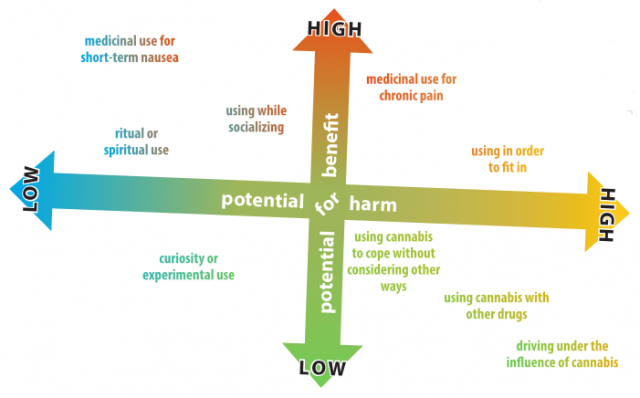
The potential that drug use might lead to certain harms and/or benefits is influenced by several things:
-
More drug equals more risk. Increased risk is linked with a greater amount and more frequent drug use, and higher strength of a drug.
-
Younger age equals more risk. The younger a person is when they start using a drug regularly, the more likely they are to experience harms or develop problematic substance use later in life.
-
Places, times and activities influence risk. Trying cannabis with friends at a weekend party and walking home later is less likely to result in harm than smoking cannabis on school property or driving under the influence.
-
The reasons young people use cannabis are important. Curiosity or experimentation often lead only to occasional use. Youth may use cannabis as a way to feel better, reducing anxiety in social situations and helping them connect with friends. While using cannabis can help reduce the symptoms of anxiety and depression, if young people use cannabis regularly to ease troubling feelings, use can become problematic. If a youth uses cannabis to perform better at school or fit in with a particular group, they may be listening to others, rather than valuing their own needs and wants, which can result in poor choices.
The reasons a young person uses cannabis, family history, the context, amount and way in which they use the drug all contribute to whether that use is beneficial, harmful, or both. Risks related to cannabis use vary from person to person, and sometimes, from day to day for a particular person. This can make deciding if, when and how to use cannabis difficult. Parents often have to weigh potential benefits and harms, and guide decisions in their particular family situation.
So, with this in mind, and in light of what the research tells us, let's take a closer look at some of the common claims about cannabis.
PSYCHOACTIVE SUBSTANCES are drugs that affect our central nervous system (especially the brain) and make us see, think, feel, and behave differently than we usually do.
Common claims about cannabis
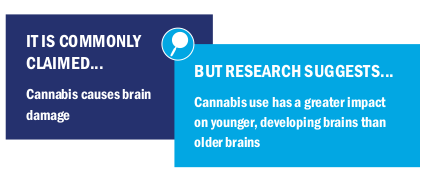
The human brain begins to develop in the womb but is not fully formed until well into adulthood. Drugs influence the way our brains develop. Regular cannabis use at an early age may have negative effects on brain development.
All psychoactive substances, from caffeine to heroin, have an immediate effect on the brain. The negative effects of cannabis, however, are much less than the effects of some substances such as alcohol.
While the negative effects of cannabis on the brain are often minimal and reversible, exposure to psychoactive substances during development should be minimized.
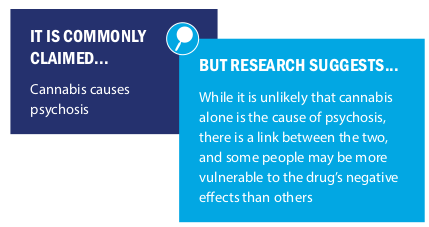
Available evidence cannot answer whether or not cannabis causes psychosis. But it does reveal an association between the two, with greater risk of psychosis for people who use cannabis frequently.
Cannabis may be one factor that interacts with other factors, such as a vulnerability to psychosis. For instance, someone with a family history of psychosis may be more sensitive to the potential psychosis-producing properties of cannabis than people without this vulnerability in their family.
That said, for some people, cannabis use can result in short-term psychotic symptoms such as unusual perceptions and feelings (e.g., they may hear voices or think someone is trying to harm them). Cannabis use can also negatively affect a person living with a psychotic disorder such as schizophrenia.
Studies on the effects of cannabis use on depression are also inconclusive. Some evidence suggests a link between frequent cannabis use and depression. But it is not clear how much of the relationship is based on cannabis use and how much is due to other factors such as family and social problems, living in poverty and other situations that may be beyond the person's control.

Even though cannabis smoke contains carcinogens (cancer-causing toxins), the risk of developing some cancers (e.g., mouth, tongue and lung) is less for cannabis smokers than tobacco smokers. This is because cannabis smokers tend to smoke less. Cannabis smokers typically smoke one to three cannabis cigarettes a day compared to 10 to 30 tobacco cigarettes by tobacco smokers.
Another factor is related to the properties of the cannabis plant. For example, cannabis contains chemicals called cannabinoids, which some scientists think play a protective role against cancer in the lungs.

While there is an association between cannabis and quitting school, the linkages may be the result of common factors— personality traits or family issues, for example—that increase the risks of both cannabis use and dropping out of school. Or school policy related to cannabis use may be the cause. For instance, a zero-tolerance school policy for drug use, which isolates suspended students from their peers and teachers, may be more likely to lead to a student dropping out than drug use itself.

While there is an association between cannabis use and the use of other illicit drugs, the apparent linkages are related to personal, social and environmental factors rather than the effects of the drug.
Personal factors include particular personality traits (e.g., sensation seeking) which might drive a young person to use cannabis and go on to try other illicit drugs. Or a young person might try cannabis to relieve symptoms of a mental health problem (e.g., anxiety) and experiment with other substances to see if they have the same effect.
Social and environmental factors related to the use of other illicit drugs include how acceptable particular drugs are in the young person's social group, and how available they are in their community.
As parents, thinking about cannabis and making decisions with your family can be a complex and challenging task. Personal history and attitudes to drug use, family values, medical history, legal status, community mores, and individual desires are factors that can affect what you choose to do. Thoughtful consideration of the issues can take some time. It is important to remember that you will make the best decision you can at that moment. You can re-evaluate your position and make different decisions as the situation and information available changes.
Is cannabis legal?
Cannabis is regulated in the province of BC. You must be 19 or over to purchase, possess or use cannabis or cannabis products for non-medical purposes in BC. It is illegal to sell or give cannabis to people under 19. People under 19 may not legally possess cannabis unless authorized to use it for medical purposes by their health care practitioner. Access to medical cannabis is regulated under the Access to Cannabis for Medical Purposes Regulations (ACMPR). Under the ACMPR, Canadians (including those under 19) who have been authorized by their health care practitioner to access cannabis for medical purposes are able to purchase safe, quality-controlled cannabis from one of the producers licensed by Health Canada, produce a limited amount of cannabis for their own medical purposes, or designate someone to produce it for them.
For more information on cannabis regulations in BC visit: http://cannabis.gov.bc.ca/
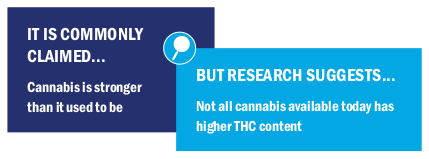
Data on the potency or strength of cannabis is limited, but the available evidence suggests there is a wide range in levels of THC (the main psychoactive ingredient). While there has been an increase in the average THC level over the past two decades, the rise has not been dramatic. Increases in THC levels are primarily related to selective breeding and more advanced cultivation techniques.
While the long-term negative effects of higher-potency cannabis on respiratory health or mental health are unknown, some researchers point out that using smaller amounts of higher potency cannabis reduces a person's exposure to smoke and toxins and therefore might reduce risks. Clinical studies have shown that smokers regulate their dosage according to the strength of the cannabis by taking smaller or fewer puffs and/or inhaling more air with their puffs.
Cannabis purchased through government outlets in BC is tested for quality. If purchased from a dealer or friend the THC content may not be known, and people may use more than desired, and, in doing so, may experience negative consequences.
What is THC?
THC is short for the chemical compound delta-9-tetrahydrocannabidinol. THC is the most talked-about active ingredient in cannabis because it delivers the "high" feeling associated with using the drug.

Cannabis affects driving ability, including reaction time, lane maintenance, information processing, speed and distance estimation, eye movement control and attention. It also causes fatigue, which is itself a driving hazard. For these reasons, it is safest to avoid driving for three to four hours after using cannabis.
Cannabis in combination with even small doses of alcohol is a greater threat to safety than either drug used alone.

In the three to four hours after using cannabis, a person may have problems remembering or learning things. If a young person uses cannabis before or during school or work, these effects could impair their ability to do well in school or perform at work. However, most of the evidence suggests that any long-lasting effects on learning and memory are minimal.
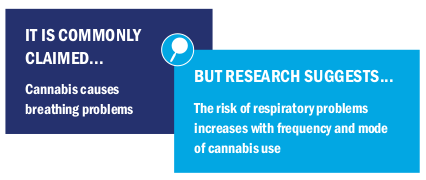
Any kind of smoke can irritate the respiratory tract. People who smoke cannabis on a regular basis can develop inflammation in their respiratory tract (the part of the body involved in breathing). This can put them at risk of chronic coughing, shortness of breath and wheezing.
Using a device called a vaporizer can reduce the risk of respiratory problems. But "safest" does not mean “no risk.” Using a vaporizer only reduces smoking-related risks, not those related to the drug itself.
Comparing common ways to use cannabis
Some ways of smoking cannabis are safer than others. For example, using unfiltered joints is less risky than using water pipes (aka bongs) and joints with cigarette filters.
With unfiltered joints, cannabis smokers inhale less tar and more THC, the active ingredient in cannabis. Cigarette filters and water pipes reduce the THC, leading smokers to inhale more vigorously and increase the amount of tar in their lungs.
Vaporizers are the safest way to use cannabis. They release THC as a fine mist while reducing the toxic by-products of smoked cannabis. Ingesting cannabis also avoids the risks related to smoke and toxins but introduces other concerns. For instance, it is harder to find the right dose because it takes longer for the body to absorb the THC. This can result in a person using more than they intended and maybe having a negative or even scary experience.
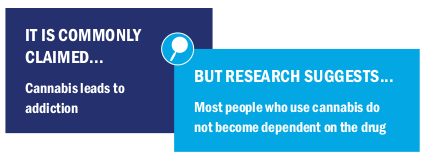
While most people who use cannabis do not progress to problematic use, those who use cannabis frequently (daily or near daily) over a period of time may be putting themselves at risk of dependence.
A person may be dependent if they feel like they need to use cannabis just to feel normal and function during the day. People who stop using cannabis after regular use can experience mild feelings of withdrawal. Common symptoms of cannabis withdrawal are restlessness, nervousness, irritability, loss of appetite and difficulty sleeping.
The risk of developing dependence is higher for those who start to use cannabis regularly at an early age.
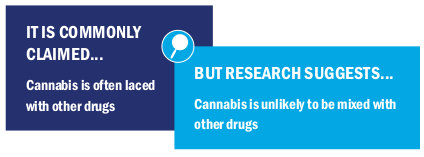
While some people worry that cannabis sold on the streets may be laced with crystal meth or other unpredictable substances, there is little evidence of this happening.
It is important to know the source of your cannabis. Buying from government distribution centres is safest.
Exploring medical cannabis use
Cannabis has been used as a medicine in many parts of the world for thousands of years. These days, many people in Canada want more evidence about what cannabis is (and is not) effective in treating, and the best way to deliver that treatment.
As it stands today, there is scientific evidence of the therapeutic benefits of cannabis for the following conditions: anti-spasm for multiple sclerosis, anti-convulsive for epilepsy, anti-nausea for chemotherapy, and appetite stimulant for people experiencing extreme weight loss. Recent research has shown cannabis is effective in managing pain.
Although cannabis can impact mental health in certain circumstances, some people with a mental health problem use it to relieve the symptoms of their condition or the unpleasant side effects of their medication.
When it comes to youth, research suggests that young people may be using cannabis for reasons that are similar to those of adults. Some studies suggest that youth experiencing mental health problems might be seeking relief through cannabis use. Mental health issues such as depression, insomnia and anxiety were reported as significant problems that interfered with their ability to function at school and with family and friends.
More research is needed to understand whether cannabis may have a place among treatment options for mental health problems such as anxiety and ADHD. For instance, evidence shows that cannabis has the potential to both increase and reduce anxiety. Some researchers believe these conflicting effects may be a reflection of the various cannabinoids in cannabis.
THC and other compounds in cannabis—notably CBD or cannabidiol—are being studied for their healing potential. Researchers believe that the ratio of THC to CBD is a crucial factor in how cannabis affects a person's mind and body.
You and your child
When you're thinking about talking with your child about drugs, knowing about some of the risks (and benefits) of cannabis use may help you feel more prepared. But it is not the most important way you can help your child navigate their world, a world where drug use is common.
More than information about cannabis, what your child needs is YOU. Research suggests that one of the most important factors in healthy child development is a strong, open relationship with a parent.
Intuitively, most of us already know this. But sometimes it helps to remind ourselves that it is our attention, love and patience that really count. It may also be helpful to remember that, ultimately, our goal as parents is to find ways to inspire our children to want to communicate with us—about cannabis or anything else.
Opening up a discussion about cannabis may be one way to strengthen your relationship with your child. It may encourage open lines of communication about other topics too. Inviting and allowing open, honest conversation about cannabis (or any other subject) makes your child know that what they are thinking, feeling and experiencing matters to you.
The exact words you use are less important than the underlying message you are sending—engaging in conversation with them says that you want to establish a connection with them, one that you hope lasts for a long time.

Connecting through conversation
Talking about cannabis or other drugs may not always be easy, fun or comfortable. But it may help to keep in mind that most people with kids struggle with parenting at least some of the time. No matter what you are going through as a parent, chances are there are others going through the exact same thing. In other words, you are not alone in your fears and frustrations—or in the joys and triumphs—of being a parent.
Starting a conversation
Some parents wonder when, where and how to start a conversation about cannabis. They ask themselves or others, "What age is the right age to start talking about drugs?" or "Should I ask the questions or should I wait until my child asks me something?"
Every child is different, so there is no "right age" to start talking about cannabis. But it makes sense to have your first conversation before your child is likely to try using cannabis. That way, you can establish a connection and share your expectations before they are exposed to any risks associated with cannabis.
There is no rule about how or where a conversation about cannabis should start either. But considering how often drugs are talked about on TV, in the newspaper, on social media, and at school, the subject might easily be brought up naturally while watching a movie together or while swapping stories about what happened at work and school that day.
Another "natural" way to start a conversation about cannabis is to bring it up in the context of other drug use. For instance, if you are planning to visit a relative who uses tobacco, you could inform your child about it and ask them what they know about smoking or how they feel about smoking. Or if you are having a beer or taking medication, you could ask, "Why do you think some people accept the use of alcohol and medication but not cannabis?"
It may be more comfortable to talk when you are not sitting across the table looking directly at each other. Try starting a conversation in the car or on the basketball court. You could say, "I've heard things on the news about kids smoking pot at school. How about your school? How does your principal deal with students who use drugs?"
Monitoring your motives
The goal of open communication is to get your child talking and sharing their thoughts and feelings with you. Ideally, they will one day ask you what you think and feel about things too. Establishing a connection through conversation is more important than assessing the details of what they tell you. After all, it is not really an open conversation if you are only inviting your child to talk so you can jump on them for ideas you do not like.
Practising good conversation skills
Your child, like anyone else you talk to, will be a better conversation partner if you stick to some basic rules about communication.
-
Be a good listener. Avoid the temptation to shower them with wisdom, and let them do at least half of the
-
Acknowledge their point of view. This does not mean you have to agree with what they say, but instead, to try not to react in a way that will shut down their desire to tell you how they think and feel about things.
-
Use open-ended questions that encourage reflection and the expression of feelings and views rather than simple yes/no answers.
-
Be clear about your expectation. Being honest about how you think or feel about cannabis use, and why you think or feel that way, can offer a broader perspective to your discussion.
-
??Keep them from tuning out. Avoid "lecture mode" and judgmental comments, and keep in mind that exaggerating the negative aspects of cannabis or any drug will not work for a child who has witnessed or experienced its positive effects.
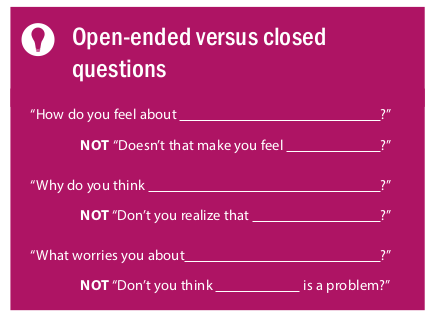
"We know when we've screwed up. We don't need to hear about it for hours. It's embarrassing enough knowing we've done something we shouldn't have and that our parents are mad about it."
Responding to your child's cannabis use
Discovering (or suspecting) your child has been using cannabis or any other drug can be scary, especially if you sense that it is not just part of "normal" experimentation.
While it can be tough to resist the urge to go wild with worry or anger, the best thing you can do for your child is to respond responsibly. It is important not to let your concerns harm the relationship and the trust you have with your child.
Stay calm
Yelling and making threats will not help the situation. If anything, "freaking out" will give your child another reason to hide things from you. Searching their room or personal belongings may harm the trust between you and your child.
Talk to your child
Sit down with them and tell them how you feel. If they are high, wait until the effects have worn off so you can have a more meaningful discussion. Say, "I'm worried because..." or "I'm afraid because..." Then give your child an opportunity to express their own feelings. Make sure they know you are really listening. And allow them time to think things through before speaking.

Learn why your child is using
Find out what led them to try cannabis in the first place. Was it because their friends were using it and they wanted to fit in? Was it for the "buzz" that comes from having an altered state of consciousness? Was it because they wanted a way to escape? Was it to manage symptoms of anxiety or other mental health problems? If so, you might want to consider seeking help from a mental health professional. It may also be helpful to find out how often your child uses cannabis.
Understand the difference between a youth who uses drugs and a youth with a drug problem
Young people use cannabis because they feel it benefits them. The most common reasons youth use cannabis are:
-
To feel good—Youth may use cannabis to feel more social, celebrate or relax. Using cannabis to feel good is associated with moderate use. There is still some risk, as there is in life in general.
-
To feel better—Cannabis can help reduce anxiety in social situations or when trying to connect with others or reduce symptoms of chronic anxiety or depression. If young people use cannabis regularly to deal with troubling feelings, then use may become problematic.
-
To do better—Some young people feel pressure to improve their performance, "get going" or "keep going."
-
To explore—Young people particularly may use cannabis out of curiosity or to “walk on the edge,” trying something new and different.
It is important to keep in mind that sustained drug use problems are most common among people who feel isolated or marginalized. Youth without connections or meaningful relationships in their lives may seek solace in "feel-good" drugs. On the other hand, even well-connected young people can get into serious trouble from using too much or in the wrong place.
Offer alternatives
If your child is using drugs because they like the buzz, you may want to suggest activities that will naturally boost their adrenaline levels, such as rock climbing or mountain biking. If your child is using cannabis to calm themselves or to relieve feelings of anxiety, you could help them explore calming or meditative activities, such as yoga, running and swimming.
Lower the risks
A child who is using cannabis may need help learning to manage the risks and use the drug in the safest way possible. One way to help your child lower the risks related to using cannabis is to have a conversation about safer ways to smoke (see Quick tips for safer cannabis use). Another way is to discuss safer contexts and settings for use. Allowing your child to smoke cannabis at home may help to provide a safer environment but it is important to weigh the risks involved.
If your child is engaging in risky activities such as using cannabis at school or selling cannabis, it is important to talk with them about why they are engaging in these activities so that you can assess the level of risk, help them think through the consequences and identify alternatives. For example, if your child is selling cannabis to make money, talk with them about safer ways to earn an income.
"It didn’t make me want to use drugs. I liked that they were honest with me."
Quick tips for safer cannabis use
-
Avoid smoking cannabis with tobacco
-
Avoid deep inhalation or breath-holding
-
Use a vaporizer
-
If smoking cannabis, use joints rather than water bongs
-
Use a small piece of rolled unbleached cardboard as a filter to prevent burns
-
Only use cannabis purchased from a trusted source
"I wouldn't want my parents to tell me if they used drugs. I'd be embarrassed."
Consider what to share (or not share) about your past
Many parents want to know if it is good or bad to tell their children about their own experiences with cannabis or other drugs. The answer is "it depends on your child and situation."
One thing to think about is your motive for talking about your past. Are you telling them because you want to warn or frighten them in some way? Are you telling them because they asked and you do not want to lie to them? Are you telling them because you feel it might enhance your relationship in some way?
Another thing to consider is that some young people have a hard time seeing how any of their parents' experiences are relevant to those of young people today. They may simply tune out when they hear stories about your past because they see no relationship between then and now.
Keep the art of motivation in mind
While no parent is 100% responsible for their child’s choices and behaviours, part of our job is to try to influence our kids in positive ways. One way involves checking in with them about their goals—over the next semester or year or even longer—and getting them to articulate how their use of cannabis or other drugs might impact those goals.
Taking a motivational approach is less about pressuring your child to change their cannabis use and more about supporting their internal reflection on their possible need and ability to change. It means steering a conversation toward possibility and action. And it is light in spirit and tone because it involves imagining success in the future.

In short, rather than make your child say and do what you want, help them identify what they want—to earn money, get a driver’s licence or graduate from high school—and support their efforts. You might need to help them understand what is involved in reaching a goal, and help them identify both internal and external resources they can draw on to ensure their success.
Give it time
It will likely take more than one conversation for you to understand your child's drug use. But the good news is that, over time, you might discover your child has less of a problem than you thought. That is, your teen could very well be experimenting with cannabis the way many young people do without ever developing a risky or harmful pattern of use.
If a harmful pattern is emerging, you will need to be even more patient. But it may help to consider this: the path to your child's drug use took time to build, so it makes sense not to expect a quick fix. A harmful pattern of drug use may be related to life challenges—feelings of failure or a lack of connection at school or with loved ones—that sometimes take a great deal of work to resolve. It might even be related to physical and mental health issues.
Signs of risky or harmful cannabis use
-
using regularly at an early age
-
daily or near daily use
-
using during school or work
-
using as a major form of recreation
-
using to cope with negative moods
-
experiencing chronic coughing, shortness of breath, wheezing or psychotic symptoms
NOTE: A young person may have one or more of these signs without having a short-term or long-term problem with cannabis. However, the more signs, the higher the risk.
Seek help
Not every parent is equipped to handle drug use issues on their own. If you need help understanding or communicating with your child, look for local resources and organizations that can assist you. You could try talking to
-
a school counsellor
-
your family doctor
-
your regional Health Authority
-
the Alcohol and Drug Information and Referral Service at 1-800-663- 1441 (BC) or 604-660-9382 (Greater Vancouver)
"The counsellor helped my child see he had other interests besides cannabis. And we learned to look at things in a more balanced way. We realized our child had more than just his pot-smoking friends in his life. He also had his sports friends and many other associations with people who didn't use cannabis."
In summary, try to remember...
As a parent, you are a powerful influence in your child's life. Your approach to life, and how you deal with good things as well as difficulties, provides multiple opportunities for your children to learn how to be human, make mistakes (whether you want them to or not) and the process of making good decisions. Life presents us with many challenges each day. How to deal with drugs, including cannabis, may be one of those issues.
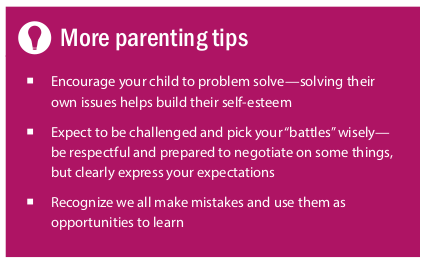
There are many things to consider, and you may struggle to make good decisions about complex issues like cannabis. Responsibilities to protect, support, and guide your children must be balanced with your values and the changing social and cultural realities of the twenty-first century. Reviewing your thoughts and feelings about cannabis, your personal history with it (did you use cannabis, do you still use it and why?) and the reasons your child is using cannabis are important considerations in thinking about what to do.
As noted earlier in this guide, young people use cannabis because they see benefit in doing so. They use cannabis to feel good, feel better, do better or explore. Entering into dialogue with your child about the benefits they receive from using cannabis will assist you to gather information and develop a mutual understanding that will help you make a good decision together about cannabis. In this process you may also discover your child has mental or physical health issues which may need to be addressed. Discussing your and your child’s concerns in the context of an open, caring and respectful relationship makes space for further dialogue on cannabis, and other issues that arise in the future.
For further information and supports please check out the resources listed on the following page.
Resources
HERE TO HELP
The following resources are available on the Here to Help website:
Other websites to visit
Canadian Institute for Substance Use Research
Dedicated to research and knowledge related to substance use, mental health and well-being. The CISUR website provides fact sheets and self-help tools to help British Columbians make decisions about their well-being. The site also includes resources to support schools, campuses and communities to take effective action in addressing the impact of substance use.
Canadian Mental Health Association (BC Division)
Promotes the mental health of all British Columbians. The website provides self-help resources, personal stories and discussion of public issues related to mental illness, such as housing, employment and discrimination.
FamilySmart
Provides a variety of supports for families and those who work with families. The website includes resources to promote greater understanding and increased collaboration among all involved in family well-being.
The Foundry
Foundry offers young people ages 12-24 health and wellness resources, services and supports – online and through integrated service centres in seven communities across BC.
Kelty Mental Health Resource Centre
Offers information and resources on mental health and substance use issues affecting children and youth including resources for parents and caregivers, healthcare professionals, school professionals, youth and young adults.
About the author

The Canadian Institute for Substance Use Research, formerly CARBC, is a member of the BC Partners for Mental Health and Addictions Information. The institute is dedicated to the study of substance use in support of community-wide efforts aimed at providing all people with access to healthier lives, whether using substances or not. For more, visit www.cisur.ca.
